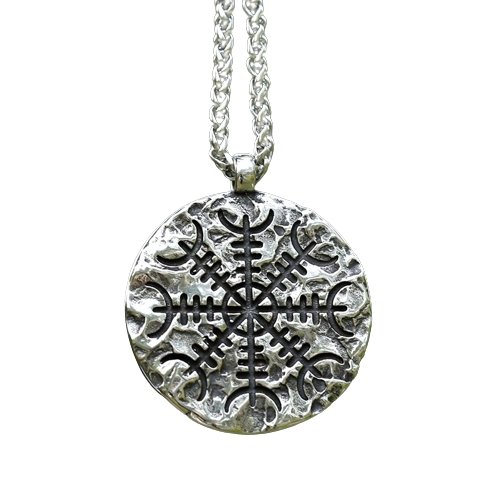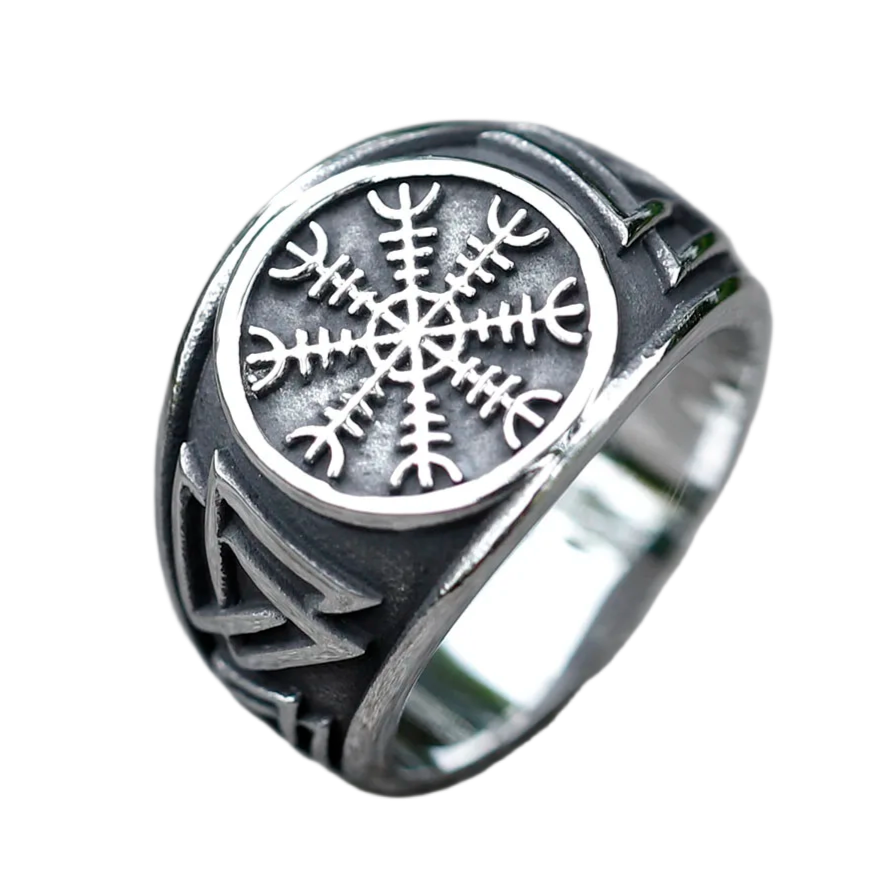Study of the Aegishjalmur: the Helm of Terror
Each of the symbols passed down from the ancient Vikings has its own meaning.
Of all those we know today, the Viking Aegishjalmur is one of the most mysterious and powerful.
Some may call it “ helm of terror ” or “ helm of Awe ”, but whatever, it always brings us back to the same questions…
In short, if you want to learn more about this Viking lucky charm, you've come to the right place.
Contents :
Origin and meaning of the word “Aegishjalmur”
A more poetic theory: the legend of Fafnir
The design of the Aegishjalmur symbol

Origin and meaning of the word “Aegishjalmur”
It consists of two distinct roots: “Aegis” and “hjalmr”, which in Old Norse mean “shield” and “helm” respectively. This Viking symbol could therefore have a meaning of “protection at the front”.
Historically, many Viking warriors actually painted this lucky symbol on their foreheads and between their eyebrows in order to protect themselves and win their battles.
Still others preferred to use it through this type of Nordic pendant or even rings of this type.
A common translation of the word "Aegishjalmur" could also be "Helm of Terror".
In reality, the words helmet and helm have the same root in the Norse language, which can sometimes lead to confusion.
The translation and interpretation which assumes that the Viking Aegishjalmur is a helmet has long put researchers on the wrong track.
Many people may have thought that this term referred to a very real type of physical helmet that would have been worn in combat.
In truth, the meaning of the Aegishjalmur is not that. In Norse, the word "bar" can also refer to "foreground", "front". Thus, the warriors who drew this symbol on their foreheads did so to protect themselves from attacks that could come from ahead.
From a more symbolic point of view, we can see it as protection against direct, frank attacks.
Like most ancient Germanic symbols, its form was not strictly fixed.
For example, the 41st spell of the Galdrabók, a 17th century Icelandic grimoire, includes a drawing of the Helm of Awe with only four arms and without the sets of perpendicular lines on its arms.

The strength of a Viking?
With these lucky symbols and jewelry
A more poetic theory: the legend of Fafnir
The character from Norse mythology most associated with the Aegishjalmur is undoubtedly the dwarf Fafnir, the son of King Hreidmar. He and all members of his family were wizards who were notably known for their ability to shapeshift.
You should know that his father was incredibly rich, and it was Fafnir who had the heavy responsibility of guarding the family treasure.
Among all their riches was a very special item: the Helm of Terror. Engraved with a strange symbol, the dwarf Fafnir wore it to increase his physical strength and thus discourage envious people from approaching the treasure.
The dwarf family also being a wizard family, there was nothing surprising that he had this kind of enchanted object.
Mythology specialists believe that it was this legend that gave the Aegishjalmur its importance among the population. By associating it with an influential character who knows how to use magic, this symbol could only be seen as very powerful.
Anyway, later the helmet came into the possession of the Viking hero Siegfried. At the same time, Loki, the god of trickery and deception, gave the king of the dwarves a cursed ring that instilled in the hearts of all who saw it an uncontrollable desire to possess it.
This led Fafnir and his brother Regin to kill their own father in order to gain the ring. Obviously, the two brothers also fought among themselves, each wanting to be the sole owner of the precious object.
It was at this moment that Fafnir transformed himself into a hideous dragon in order to frighten his brother.
What connection with the Aegishjalmur you will tell us!
Well there was actually a third thief in the race: Siegfried, the owner of the magic helm.
Deciding to stop this madness, Siegfried killed the two brothers himself. He then took the ring and Fafnir's other treasures. From that day on, no one ever heard of these cursed artifacts.

The design of the Aegishjalmur symbol
The Aegishjalmur is roughly composed of eight tridents pointing outwards, almost as if they were seeking to protect the central point from any damage.
Obviously, even if we don't have much knowledge about this symbol, its design can evoke some feelings in us, such as fear or a need for protection.
By studying it further, we can see the connection it has with runes (a sacred writing system in Norse mythology).
In fact, many shapes found in the Helm of Terror turn out to be similar to certain runes:
- His arms resemble the Algiz rune (the “Z” shaped rune). It represents protection and security arising from connection with the gods and the sacred.
- The "peak" of Aegishjalmur can be associated with the rune Isa. This is often presented as ice that freezes everything around it. Some see it as the rune of perseverance
This link with the runes obviously doubles the power of the helm of terror. It is not only protection against physical attacks also spiritual protection that it offers us.
After all, every warrior's end goal is to overcome their fear and bring their enemies to their knees. It is clear that this required a good dose of perseverance and therefore effective protection against psychic attacks.
Thus, many saw the Viking Aegishjalmur as a source of courage allowing them to overcome any difficulties that might arise in their lives.
Note, however, that this link with the runes is not a one-off. Many Viking symbols (of which you can discover some here) use them to potentiate their powers.

Discover runic magic
Secrets and power of Viking seers
How does the Helm of Terror work?
There are various sagas that refer to the Aegishjalmur, but none offer us the slightest detail as to the mysteries of its workings. However, we do have some information that we can use.
In early Norse tradition, the helm of Awe was applied, using lead paint or copper, to the foreheads of warriors during magical rituals.
Later, around the 14th century, the symbol was instead painted on physical helmets that Scandinavian soldiers of certain clans wore to war.
According to some, the Viking Aegishjalmur is much more powerful when painted directly on the skin. For others, using headphones increases the effects...
In the end, however, everyone agrees that this Nordic lucky symbol does indeed work.
This is apparently linked to an ancient form of Viking magic: Seidr.
Seidr is a branch of magic that ancient northern peoples used to deal with destiny.
Masters of the seidr could perceive the lines of destiny woven into a person's existence, and sometimes even modify them in order to change their future, thus rewriting history with their own hands.
Additionally, this type of Viking magic also had an entire branch dedicated to illusion. This is what would have given the Aegishjalmur its power.
In fact, when a warrior used this symbol, the perception and capacity of judgment of the people (friends and enemies) around him were modified. Thus, he could appear much more powerful and frightening than he actually was.
Through this effect, the Viking Aegishjalmur created a sort of protective sphere around its wearer who saw all his enemies approaching him as far away as possible.

Conclusion on the Helm of Awe
Here we have just described one of the most mysterious and powerful symbols of Norse mythology. In Scandinavia it was associated with divination, runestones and fabulous legends.
Later shared with Celtic and Germanic cultures, the Aegishjalmur will forever remain a magical symbol of the North, a symbol of protection offering aid to the brave and valiant. Its runic inscriptions make it a robust armor, but also a compass, capable of guiding.
Often, just looking at it is enough for a feeling of fear of discomfort to invade us. Thus, the Viking Aegishjalmur helps protect us from a number of external attacks, and therefore constitutes a formidable good luck charm for fighters of all kinds.
Its resolutely Scandinavian style appeals to people with a bohemian, gothic or simply traditional style.
This Viking symbol is in any case heavy in symbolism. Whether we think of its connection with the seidr or with the runic alphabet, it is clear that we are talking here about a sign of great importance.
And you, what do you think about the meaning of Aegishjalmur?
Discover this article in video format
Lucky charm featured in this article

Aegishjalmur Ore Amulet
See more
Aegishjalmur Ring
See more
